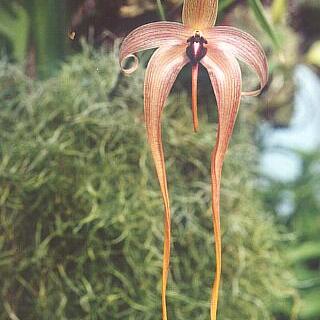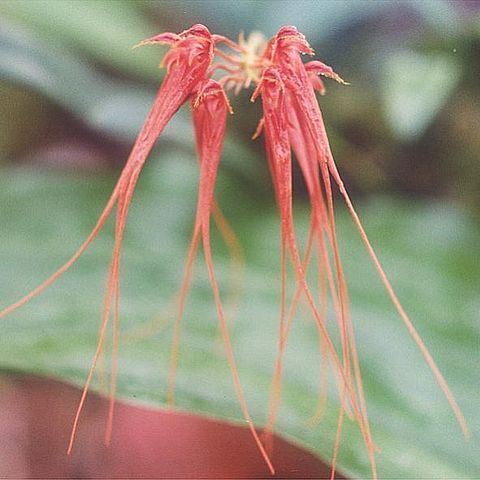Herbs, epiphytic. Rhizome usually rather long, creeping or hanging, usually bearing a series of pseudobulbs, very rarely without pseudobulbs. Pseudobulbs well spaced to clustered on rhizome, each with a single joint. Leaves 1 or rarely 2 or 3, arising from apex of pseudobulbs or very rarely directly from rhizome; leaf blade usually leathery, varying in size. Scape arising laterally from base of a pseudobulb or from a node of rhizome; inflorescence usually racemose or umbellate, 1-to many flowered; floral bracts often small. Flowers small to large. Sepals subequal in size or lateral sepals much longer than dorsal one; lateral sepals free or ± connate on lower or upper edges, base adnate to column foot forming a short mentum. Petals free, usually smaller than sepals; lip often hinged to end of column foot, mobile or sometimes immobile, usually fleshy and recurved. Column short, winged, base with a distinct foot; wings often dilated to form teeth or stelidia; anther 2-locular, sometimes 1-locular; pollinia 4, in 2 pairs, waxy, without appendages, sometimes attached to sticky substance.
Infl. of various forms, in small plants fls solitary or in simple racemes, us. arising at base of a pseudobulb; floral bracts often small. Per. large to very small; labellum sts apparently uppermost; dorsal sepal free, often short; lateral sepals adnate to column-foot (forming a mentum), free or ± connate; petals us. < sepals. Labellum scarcely lobed, hinged to end of column-foot, us. mobile. Column short, us. with ± horned wings, its foot long; anther narrowly joined to column just below its apex, caducous, pollinia 4, ± waxy, without caudicles; stigma concave, just below anther. Plants epiphytic or rupestral; rhizome creeping or hanging, each segment ending in a swollen internode or pseudobulb carrying a lf on top; sympodial growth continued by rhizome from base of pseudobulb. Lvs various. Genus of > 1,000 spp., mostly in the tropics of America, Africa and Asia, extending north to Japan and south to Australia and represented in N.Z. by 2 spp., at least one of them endemic.
Epiphytic or lithophytic herb with sympodial growth. Rhizomes creeping, often woody, sometimes branched. Pseudobulbs each comprising 1 internode (representing the main axis of a sympodial branch), clustered or spaced out along the rhizome, 1-or 2-leaved at the apex. Leaves mostly coriaceous or fleshy, rarely thin-textured. Rachis sometimes swollen or flattened; flowers white, cream, yellow, green, orange or purple, ± fleshy. Inflorescences arising from base of the pseudobulb, racemose or rarely umbellate, 1-to many-flowered. Sepals usually free and subequal, the lateral sepals united at the base to the column foot to form an obscure mentum. Petals usually smaller than the sepals. Lip often much smaller than the sepals, hinged to end of the column foot, usually motile, often fleshy and tongue-like, sometimes fringed with long or short hairs. Column short, usually with apical lateral extensions (stelidia), and often winged. Pollinia 2 or 4 in 2 pairs.
Epiphytic herbs, with short, subconic or angulate, 1-to 2-leaved pseudobulbs often widely spaced along a creeping rhizome. Inflorescences erect or arching spikes or racemes produced from the base of the pseudobulbs. Flowers numerous, inconspicuous, subtended by a bract, free on short pedicels or sessile in shallow pits on the fleshy peduncle. Sepals free, or the laterals connate and obliquely dilated at the base, adnate to the foot of the column. Petals smaller than the sepals, with entire or ciliate margins. Lip simple, fleshy, or with a thickened basal callus, con-tracted at the base and hinged to the column foot. Column short, erect, produced at the base into a foot. Anther terminal, operculate, incumbent, depressed-hemis-pherical or obtusely conical, usually 2 celled; pollinia normally 4, waxy, in pairs in the cells of the anther.
Herbs, epiphytic or lithophytic, sympodial. Roots velamentous, glabrous. Stems rhizomatous, covered by scarious sheaths; pseudobulbs often angled, ovoid, stout. Leaves conduplicate, articulate, thin to leathery. Inflorescences lateral from base of pseudobulb, spikes [racemes], erect to pendent, pedunculate, rachis swollen, fleshy. Flowers resupinate, sessile; dorsal sepal distinct and free; lateral sepals adnate to column foot forming mentum; petals distinct and free, smaller than sepals; lip fleshy; column erect with aristate terminal teeth or wings; anther terminal, incumbent, operculate; pollinia 2 or 4, hard, waxy; stigma entire; ovary sessile [pedicellate]. Fruits capsules, beakless. x = 19, 20.
Lip often much smaller than the sepals, hinged to end of the column foot, usually motile, often fleshy and tongue-like, sometimes fringed with long or short hairs.
Pseudobulbs each comprising 1 internode (representing the main axis ofa sympodial branch), clustered or spaced out along the rhizome, 1–2(3)-leaved at the apex.
Sepals usually free and subequal, the lateral sepals united at the base to the column foot to form an obscure mentum.
Inflorescences arising from base of the pseudobulb, racemose or rarely umbellate, (1)few-to many-flowered.
Rhachis sometimes swollen or flattened; flowers white, cream, yellow, green, orange or purple, ± fleshy.
Column short, usually with apical lateral extensions (stelidia), and often winged.
Leaves mostly coriaceous or fleshy, rarely thin-textured.
Epiphytic or lithophytic herb with sympodial growth.
Rhizomes creeping, often woody, sometimes branched.
Petals usually smaller than the sepals.
Pollinia 2 or 4 in 2 pairs.


